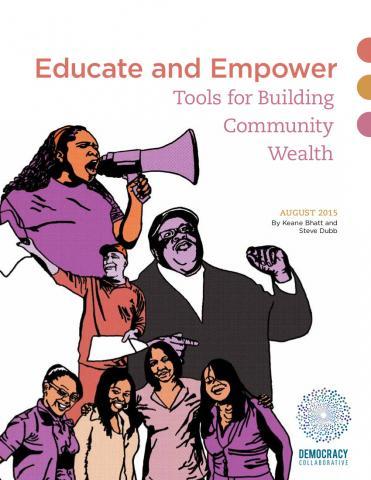
Crossposted from the Stanford Social Innovation Review (SSIR)
In the late 1980s, the 14-year-old son of two Cape Verdean immigrants started tagging along with his aunt to community group meetings in Roxbury, Boston. The organization, Dudley Street Neighborhood Initiative (DSNI), was in the middle of a celebrated campaign to build a participatory, grassroots vision for the community’s economic future—a campaign that would ultimately lead to the building of hundreds of permanently affordable, community-controlled housing units. Despite his age, this teenager found plenty of opportunities to plug in and was among the first youth elected to the deeply democratic DSNI board of directors. Later, he would serve as its executive director. Today, John Barros is the chief of economic development for the entire city.
While the story of Barros and DSNI is certainly exemplary, it’s also not entirely anomalous. We discovered many such inspiring stories during our recent study on building community in the United States. As part of our research, we looked at 11 organizations that engage in community wealth building—that is, strategies that use community ownership of business and land to generate income-producing assets and build wealth in low-income communities over time. They include a group that developed a shopping center in San Diego jointly owned by community members; a technical assistance center at Kent State that has helped 15,000 people become employee-owners over the past 25 years; and a group in Worcester, Mass. that launched an employee-owned upholstery company, with a second business in development.
Our research revealed that the capacity of low-income communities to engage in inclusive local economic development doesn’t happen on its own; it requires that organizations dedicate time and resources to nurturing community-building skills and values. Such efforts are critically important, because they provide mechanisms by which low-income communities can generate assets, and begin to reverse the nation’s growing income and wealth inequality. Community wealth building is also a strategy low-income communities and communities of color can use to recover from the massive loss of wealth suffered in the Great Recession—a loss estimated to exceed $1 trillion.
As more and more local governments and community foundations—in places like Richmond, Virginia; New York City; Rochester, New York; Denver, Colorado; and Cleveland, Ohio—turn to community wealth building to strengthen local economies and reverse decades of disinvestment, it’s high time to pay attention to how education and community-organizing strategies can help empower people to actively shape their economic destiny.
Making this happen requires that we get beyond the simple binaries of “top-down” or “bottom-up” solutions that too often limit our understanding of what really works. Our research showed that even local community groups like DSNI regularly engage outside experts to strategically expand the capacity of their constituents so that they can work effectively on complex issues. Meanwhile, many large nonprofits—despite considerable in-house staff and financial capacity—find investing in grassroots capacity building to be mission-critical. Two years ago, for example, New Community Corporation (NCC)—which serves thousands of people in Newark, New Jersey, and owns hundreds of millions in assets—created an executive-level position to foster grassroots engagement. It hired Director of Mission Frances Teabout. Teabout says her job is designed to help community members “see how they fit into the larger picture,” which she sees as necessary to maintain organizational effectiveness.
In short, we need to jettison both the assumption that low-income communities are incapable of tackling complex economic issues and the assumption that anything but 100 percent grassroots action is suspect. Instead, we need to focus on ways to get resources and knowledge to the communities that need them the most, while maintaining accountability.
Education is central to this vision. There is a rich history of experience in this field. Jane Addams and John Dewey in the early 1900s pioneered the development of practical community-based learning—Dewey with his emphasis on “learning by doing” and Addams through her promotion of immigrant-based community centers known as “settlement houses.” Later on, Paulo Freire deepened this practice of practitioner-focused learning, prioritizing techniques that increased engagement by using the education process to address real world problems that participants faced. These principles have widespread application: For example, study circles and learning journeys underpinned the history of cooperative economic development in African American communities.
It’s clear that such investments in education pay off. For instance, the largest worker cooperative in the United States, Cooperative Home Care Associates (CHCA), employs over 2,000 people—mostly women of color—and puts education at the core of its operations. It helps members acquire the skills they need to both succeed on the job and engage with their employer’s democratic governance. Cooperation Texas, an innovative grassroots worker cooperative incubator, similarly focuses on helping a largely immigrant constituency develop the skills they need to collectively build and launch new democratic workplaces. We found that such education works best when it “meets people where they are at” and benefits from engaging community members—especially those facing challenges around literacy, numeracy, and English fluency—in participatory, tactile, and visual exercises.
Empowering communities to take control of economic development is slow, patient work—and people funding or supporting it need to take this into account when assessing success. Long-term, place-based commitments are critical; parachuting in and out does little to build local capacity. And the metrics we use need to take into account the often intangible relationship-building that weaves together a truly empowered community; shortcuts and quick fixes can cause real damage. As Clarke Gocker, who works for Buffalo’s People United for Sustainable Housing, emphasizes, empowering communities requires that we create “a nonjudgmental, safe space to come into, where people aren’t afraid to say, ‘slow down.’ That’s how we build trust and social capital among one another. It’s a long haul, and there’s no instant gratification.”
- See more at: http://ssir.org/articles/entry/communities_building_their_own_economies#sthash.jPVvmvs7.dpuf